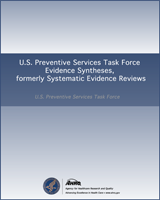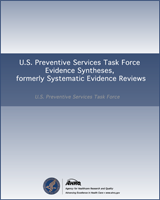NCBI Bookshelf. A service of the National Library of Medicine, National Institutes of Health.
This publication is provided for historical reference only and the information may be out of date.
Structured Abstract
Background:
Illicit drug use and abuse are serious problems among adolescents, adults, and pregnant women in the United States, and approximately 3.2% of the population age 12 and over meet criteria for a drug use disorder. Many individuals with drug use disorders have co-existing mental and physical health conditions.
Purpose:
To update the 1996 U.S. Preventive Services Task Force (USPSTF) recommendation on screening for drug misuse in primary care. The USPSTF previously concluded there was insufficient evidence to recommend for or against routine screening for drug misuse. This report describes a staged, systematic review that assessed whether the evidence for selected critical key questions is now sufficient for the USPSTF to make a recommendation on this topic.
Data sources:
Ovid MEDLINE, PsycINFO, and the Cochrane Database of Systematic Reviews, from 1994 through April 2006. Literature searches were supplemented with materials recommended by experts in the field and from reference lists in included articles.
Study Selection:
We developed an analytic framework and identified five critical key questions (KQ) to examine evidence sufficiency in a causal chain linking primary care screening for drug misuse to treatment outcomes and longer-term health benefits of reductions in illicit drug use. We focused on the most prevalent and/or harmful substances: illicit opiates, cocaine, and cannabis. Using inclusion/exclusion criteria specific to each critical KQ, we reviewed a total of 4587 abstracts for all key questions and 41 full-text articles for inclusion regarding direct evidence of health benefits of drug screening programs in primary care, 127 articles for inclusion regarding drug misuse treatment outcomes in primary care-screened populations, and 79 articles for inclusion regarding improvements in health or mortality following reduction in or cessation of illicit drug use. Inclusion criteria for drug misuse treatment articles required randomized controlled or controlled trial designs comparing a treatment to placebo or minimal treatment control; comparative effectiveness trials were excluded. Using USPSTF and other published methods, we critically appraised studies using quality criteria specific to their design. We listed studies excluded from analysis and rationales for their exclusion.
Data Extraction:
We abstracted, critically appraised, and synthesized 28 articles meeting our criteria for all critical KQs. Abstracted elements were arrayed in evidence tables, using abstraction criteria specific to each KQ.
Data Synthesis and Results:
We qualitatively summarized the findings, with an emphasis on the best available evidence for each critical KQ and the overall coherence of the evidence. We found no evidence addressing the effects on health outcomes of screening in primary care settings to identify and treat drug misuse among asymptomatic individuals. We found no evidence that drug misuse treatment affects health outcomes among individuals screened in primary care, and found little qualifying evidence in non-screened (treatment-seeking) populations. We found fair to good evidence that various drug misuse treatments—including pharmacotherapies and behavioral interventions—effectively reduce opiate, cocaine, or marijuana misuse. All but one of the 17 included drug misuse treatment trials were conducted among treatment-seeking, instead of primary-care-screened populations. The exception was a brief motivational intervention that reduced cocaine and opiate use among primary care patients identified through screening for use of these substances. We found less consistent evidence of drug misuse treatment effects on social and legal outcomes, although behavioral counseling interventions for cannabis misuse appear to reduce cannabis-related problems. We found fair evidence that stopping or reducing drug misuse is related to reduced mortality and morbidity, although none of this evidence was derived from individuals screened for drug misuse in primary care settings.
Conclusions:
Although many advances in drug misuse treatment have occurred during the past decade, the vast majority of trials have been conducted among treatment-seeking populations, and thus the relevance of outcomes from such studies is of uncertain applicability to asymptomatic primary care populations that could be screened for drug misuse. Evidence that reducing or stopping drug misuse is associated with improved health outcomes similarly derives from non-screened or treatment-seeking populations, and the generalizability of these findings to general primary care populations may be limited.
Contents
- Acknowledgements
- 1. Introduction
- 2. Methods
- 3. Results
- 4. Discussion
- Appendixes
- Appendix A. Search Strategies
- Appendix B. Inclusion and Exclusion Criteria
- Appendix C. U.S. Preventive Services Task Force Quality Rating Criteria
- Appendix D. Criteria for Assessing Scientific Quality of Systematic Evidence Reviews
- Appendix E. Quality of Prognosis Studies Criteria
- Appendix G. Excluded Studies
- Reference List
This report is based on research conducted by the Oregon Evidence-based Practice Center (EPC)1 under contract to the Agency for Healthcare Research and Quality (AHRQ),2 Rockville, MD (Contract No. 290-02-0024, Task Order Number 1).
Suggested citation:
Polen MR, Whitlock EP, Wisdom JP, Nygren P, Bougatsos C. Screening in Primary Care Settings for Illicit Drug Use: Staged Systematic Review for the U.S. Preventive Services Task Force. Evidence Synthesis No. 58, Part 1. (Prepared by the Oregon Evidence-based Practice Center under Contract No. 290-02-0024.) AHRQ Publication No. 08-05108-EF-s. Rockville, MD, Agency for Healthcare Research and Quality, January 2008.
The findings and conclusions in this document are those of the author(s), who are responsible for its content, and do not necessarily represent the views of AHRQ. No statement in this report should be construed as an official position of AHRQ or of the U.S. Department of Health and Human Services.
The information in this report is intended to help clinicians, employers, policymakers, and others make informed decisions about the provision of health care services. This report is intended as a reference and not as a substitute for clinical judgment.
This report may be used, in whole or in part, as the basis for the development of clinical practice guidelines and other quality enhancement tools, or as a basis for reimbursement and coverage policies. AHRQ or U.S. Department of Health and Human Services endorsement of such derivative products may not be stated or implied.
No investigators have any affiliations or financial involvement (e.g., employment, consultancies, honoraria, stock options, expert testimony, grants or patents received or pending, or royalties) that conflict with material presented in this report.
- 1
Center for Health Research, 3800 North Interstate Avenue, Portland, OR 97227.
- 2
540 Gaither Road, Rockville, MD 20850. www
.ahrq.gov
- Review Screening for Unhealthy Drug Use in Primary Care in Adolescents and Adults, Including Pregnant Persons: Updated Systematic Review for the U.S. Preventive Services Task Force[ 2020]Review Screening for Unhealthy Drug Use in Primary Care in Adolescents and Adults, Including Pregnant Persons: Updated Systematic Review for the U.S. Preventive Services Task ForcePatnode CD, Perdue LA, Rushkin M, O’Connor EA. 2020 Jun
- Review Lipid Screening in Childhood and Adolescence for Detection of Familial Hypercholesterolemia: A Systematic Evidence Review for the U.S. Preventive Services Task Force[ 2016]Review Lipid Screening in Childhood and Adolescence for Detection of Familial Hypercholesterolemia: A Systematic Evidence Review for the U.S. Preventive Services Task ForceLozano P, Henrikson NB, Dunn J, Morrison CC, Nguyen M, Blasi PR, Anderson ML, Whitlock E. 2016 Aug
- Review Behavioral Counseling to Promote a Healthful Diet and Physical Activity for Cardiovascular Disease Prevention in Adults Without Known Cardiovascular Disease Risk Factors: Updated Systematic Review for the U.S. Preventive Services Task Force[ 2017]Review Behavioral Counseling to Promote a Healthful Diet and Physical Activity for Cardiovascular Disease Prevention in Adults Without Known Cardiovascular Disease Risk Factors: Updated Systematic Review for the U.S. Preventive Services Task ForcePatnode CD, Evans CV, Senger CA, Redmond N, Lin JS. 2017 Jul
- Review Screening and Interventions for Childhood Overweight[ 2005]Review Screening and Interventions for Childhood OverweightWhitlock EP, Williams SB, Gold R, Smith P, Shipman S. 2005 Jul
- Review Lipid Screening in Childhood for Detection of Multifactorial Dyslipidemia: A Systematic Evidence Review for the U.S. Preventive Services Task Force[ 2016]Review Lipid Screening in Childhood for Detection of Multifactorial Dyslipidemia: A Systematic Evidence Review for the U.S. Preventive Services Task ForceLozano P, Henrikson NB, Morrison CC, Dunn J, Nguyen M, Blasi P, Whitlock EP. 2016 Aug
- Screening in Primary Care Settings for Illicit Drug Use: Staged Systematic Revie...Screening in Primary Care Settings for Illicit Drug Use: Staged Systematic Review for the United States Preventive Services Task Force
- SRS4849128 (2)SRA
Your browsing activity is empty.
Activity recording is turned off.
See more...

